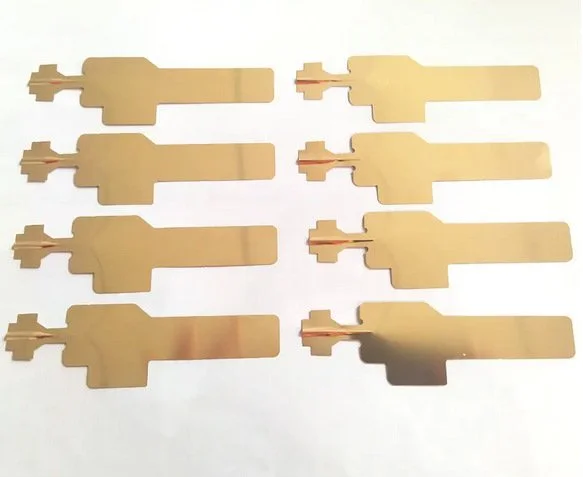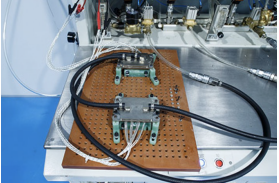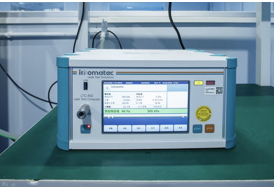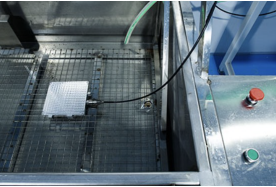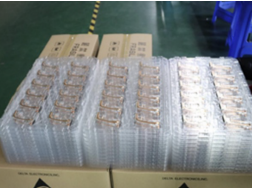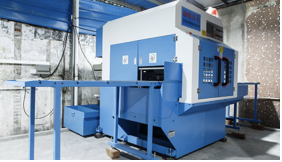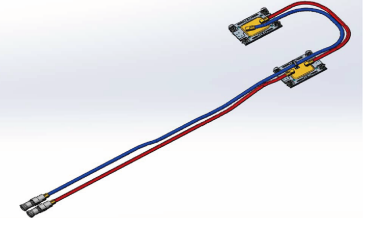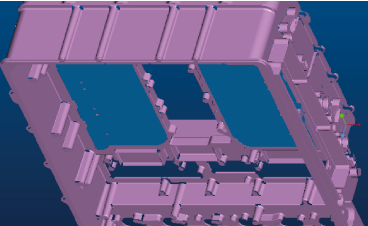VAPOR CHAMBER
A vapor chamber is a two-phase heat transfer device that is similar in design and operation to a heat pipe. It is a relatively new and innovative technology that has emerged as an alternative to traditional heat sinks. Vapor chambers have a larger surface area and a higher thermal conductivity than traditional heat sinks, making them highly effective at dissipating heat from high-power electronics and other heat-generating devices. The flat, plate-like design of vapor chambers also allows for more even heat distribution, reducing the risk of hotspots
Features
*High Thermal Conductivity: Vapor chambers have exceptionally high thermal conductivity, surpassing that of traditional heat sinks. This enables the efficient transfer of heat, allowing for improved cooling performance.
*Large Surface Area: Vapor chambers have a larger surface area compared to typical heat sinks, which facilitates better heat spreading and dissipation. This helps to prevent localized hotspots and ensures more uniform temperature distribution.
*Thin and Compact Design: Vapor chambers have a flat, plate-like structure that allows for a thinner and more compact design compared to traditional heat sinks. This makes them suitable for space-constrained applications where size and weight are critical.
*Enhanced Heat Transfer Capability: The active two-phase heat transfer mechanism of vapor chambers provides superior heat transfer capabilities. This allows for faster heat dissipation and improved cooling efficiency, making vapor chambers particularly effective in dissipating high heat loads.
*Versatility: Vapor chambers can be custom-designed and manufactured to fit specific requirements and applications. They are adaptable to various form factors and can be integrated into different electronic devices and systems.
*Reliability: Vapor chambers are a reliable cooling solution due to their robust construction. They are typically made of high-quality materials with excellent resistance to corrosion and thermal stress, ensuring long-term performance and durability.
*Noiseless Operation: Vapor chambers do not rely on any mechanical parts or fans, resulting in noise-free operation. This makes them suitable for noise-sensitive environments, such as offices, medical facilities, and residential settings.
| Unit weight | 0.0029 kg | Product Volume | 35 cm * 30 cm * 25 cm |
| Material | Copper | Stamping part | type Hardware |
| Processing Size | 23.6x18.181mm (mm) | Mould | Multi-process continuous mould |
| Tolerance | 0.01 | Surface Finish | Electroplatable |
Materials
Vapor chambers are typically made of two thin metal sheets bonded together with a wick structure in between. The metal sheets are usually copper and sometimes aluminum, and the wick structure is made of sintered copper or graphite, nickel foam, or mesh.
Copper is a popular choice for vapor chamber manufacture due to its excellent thermal conductivity, chemical stability, and durability under extreme temperatures. Its high ductility also makes it easy to fabricate and form into various shapes.
Aluminum vapor chambers have lower thermal conductivity than copper, but they are less expensive and lighter in weight. They are commonly used in high-volume, cost-sensitive applications where the heat load is moderate.
The wick structure inside a vapor chamber plays a crucial role in heat transfer by providing the means to transport the liquid back to the evaporator where it can be vaporized again. Sintered copper or graphite is a popular choice for the wick structure because of its high porosity, permeability, and capillary action, which ensure efficient liquid transport and evaporation. Nickel foam and mesh are also commonly used materials for wick structures due to their high strength and durability
Conventional Vapor Chamber
Ultra-thin Vapor Chamber
Stainless steel VC
blow-up board
Vapor chambers have a wide range of applications across various industries due to their superior thermal performance.
Application
electronic instruments
new energy vehicles
server
energy storage equipment
5G communication (base stations)
medical/beauty equipment
smart home appliances
PC consumer electronics
laser equipment
*Quality control is critical in ensuring the thermal performance and reliability of vapor chambers. The following are some of the quality control measures used in the production of vapor chambers:
*Leak Testing: Vapor chambers are pressurized with helium or other inert gases to detect any leaks in the metal-to-metal bonding or the wick structure.
*Visual Inspection: The vapor chambers are visually inspected for any deformities, manufacturing defects or surface imperfections. These could result in reduced thermal performance and durability of the vapor chamber.
*Quality Material Selection: The quality of vapor chambers significantly depends on the choice of materials used in their production. For instance, high-quality copper metal sheets, sintered copper wick structures, and high-quality bonding materials must be used to ensure the vapor chamber operates at peak performance.
*Thermal Performance Testing: Testing the thermal performance of vapor chambers is critical to ensuring they meet the desired specifications. Thermal testing involves subjecting the vapor chambers to predetermined thermal loads and monitoring their performance. A thermographic camera is used to determine the temperature uniformity and heat spreading in the vapor chamber.
*Packaging and Shipping: Proper packaging and shipping are necessary to prevent any damage to the vapor chamber. Proper packaging of the vapor chamber helps to ensure that its performance parameters are not affected by any physical damage during transport or storage.
Quality control
*Vacuum Deposition Systems: Vapor chambers often involve the deposition of materials in a controlled vacuum environment. Vacuum deposition systems, such as physical vapor deposition (PVD) or chemical vapor deposition (CVD) equipment, are used to deposit the necessary layers of materials onto the substrate to form the vapor chamber.
*Sputtering Systems: Sputtering is a common technique used in vapor chamber production. Sputtering systems utilize high-energy ions to bombard a target material, causing atoms to be ejected and deposited onto the surface of the substrate.
*Lamination Machines: Depending on the design and structure of the vapor chamber, lamination machines may be used to bond multiple layers of materials together. Lamination machines apply heat and pressure to join the layers and create a sealed vapor chamber.
*Laser Cutting Machines: Laser cutting machines are often employed to precisely cut the vapor chamber into the desired shape and size. Laser cutting offers high accuracy and can be used to create complex patterns and designs.
*CNC Machines: Computer Numerical Control (CNC) machines may be utilized for precision machining of the vapor chamber components and features. CNC machines can perform milling, drilling, and other operations to shape the vapor chamber according to the design specifications.
*Testing and Inspection Equipment: Various testing and inspection equipment, such as thermal imaging cameras, leak testers, and optical inspection systems, are employed to ensure the quality and performance of the vapor chambers. These equipment help verify that the vapor chambers meet the required thermal conductivity, sealing integrity, and dimensional specifications.
Main production equipments
Our laboratory testing equipment
United States/Germany/China/Japan/South Korea/United Kingdom/Sweden/Switzerland
The main clients
The packaging of vapor chambers is an important consideration to ensure safe transportation and protection from potential damage during handling. There are various packaging methods depending on the specific design and application of the vapor chamber. Some common packaging methods for vapor chambers include using foam inserts to protect the vapor chamber during shipping and ensuring that the foam tightly surrounds the vapor chamber.
Anti-static bags and desiccant packets can be used to prevent electrostatic damage and moisture build-up, respectively. Additionally, some companies use double-wall corrugated boxes to provide added protection and shock absorption during transport.
The packaging can also be customized to fit the particular application. For example, for electronic devices where the vapor chamber may be included in an assembly, it may be packaged in a tray with a cover to ensure the vapor chamber is properly aligned. For high-performance computing applications, such as server environments, specialized vapor chamber packaging is used to ensure that the high-power densities are adequately managed during transportation and installation.
It is important for manufacturers and distributors of vapor chambers to carefully consider the packaging methods that will best protect their components during transportation and storage. Companies may have different packaging standards depending on their specific vapor chamber design, application, and certification requirements.
Packaging
1. What is a vapor chamber?
A vapor chamber is a two-phase cooling solution used to manage heat generated by electronic components. It typically consists of a thin, flat sealed container containing a working fluid in the form of a liquid-vapor mixture. Heat from electronic components is transferred to the vapor chamber, and the working fluid absorbs this heat, evaporating into a vapor. This vapor then travels to cooler regions within the vapor chamber, where it condenses back into a liquid and releases the absorbed heat.
2. What applications are vapor chambers used for?
Vapor chambers are used in many applications that require effective thermal management of heat sources. They are commonly used in electronic devices such as computers, servers, gaming consoles, and smartphones. They are also used in high-power electronic applications such as power converters, industrial controllers, and LED lighting.
3. What are the advantages of using a vapor chamber?
Using a vapor chamber for cooling can provide several benefits, including higher heat transport capacity than traditional heat sinks, better thermal management of unevenly distributed heat sources, and improved thermal performance in high-power density applications. Vapor chambers also have a lower profile than traditional heat sinks, which can be useful in space-constrained environments.
4. How is a vapor chamber manufactured?
Vapor chambers are typically made by depositing a thin layer of wick material onto a flat metal substrate. A working fluid is then injected into the wick, and the chamber is sealed. The vapor chamber is usually completed by attaching a heat source to the top surface of the chamber.
5. What is the lifespan of a vapor chamber?
The lifespan of a vapor chamber can depend on several factors, including the materials used in the manufacturing process, the operating conditions, and the application. Generally, vapor chambers are designed to have long lifespans, with some manufacturers claiming that vapor chambers can last for up to 10 years or more.
6. How can I maintain a vapor chamber?
Vapor chambers typically do not require any maintenance, except for keeping them clean and free from dust or debris. It is important to avoid mishandling or dropping a vapor chamber, which can damage the chamber and compromise its performance.
These FAQs should provide you with a basic understanding of air-cooled heat sinks. If you have any more specific questions, feel free to ask!
FAQs
Our factory
Simulation Solution
Server Liquid Cooling Heat Dissipation Simulation Case Study
Industrial Liquid Cooling Heat Dissipation Simulation Solution
Simulation Solution for Liquid Cooling Heat Dissipation of 7KW IGBT for Rail Transit
Simulation Solution for Laser Liquid Cooling Heat Dissipation
Summary of Simulation for Optimization of Liquid Cooling Heat Dissipation in New Energy
If you are interested in heat dissipation solutions and heat sinks, please contact us by email info@tonethermal.com, and we will be at your service.


